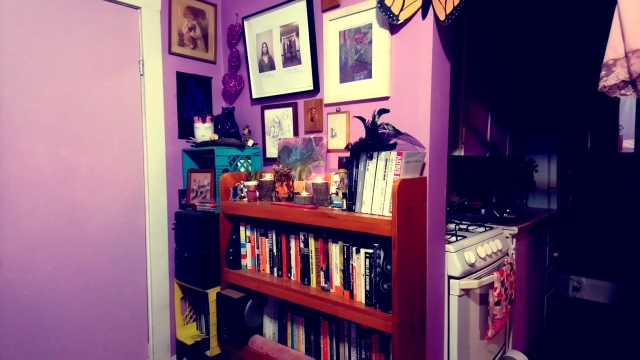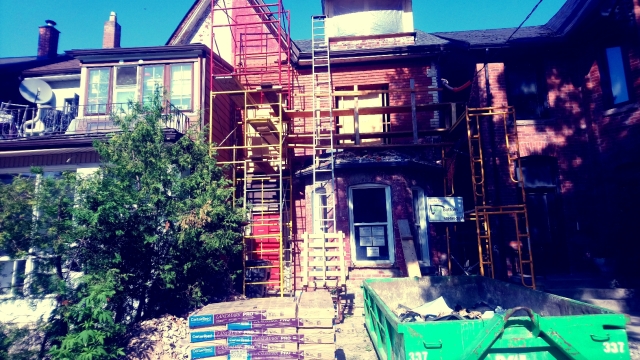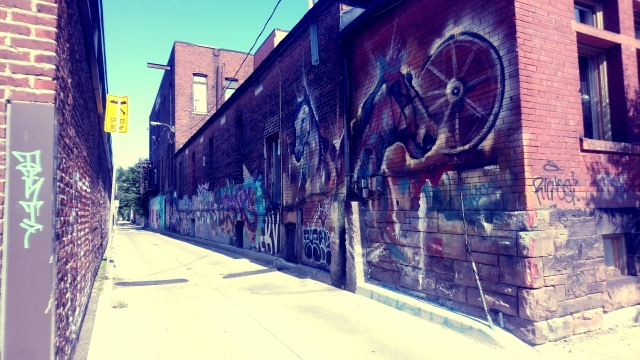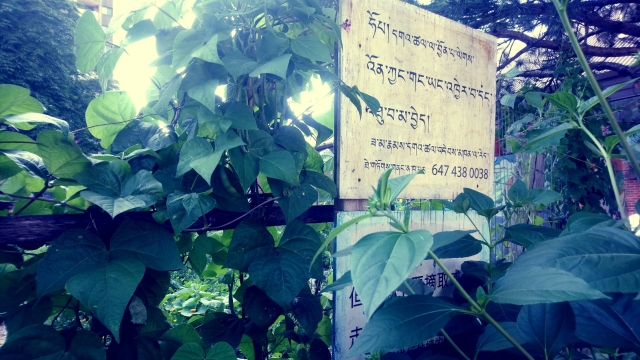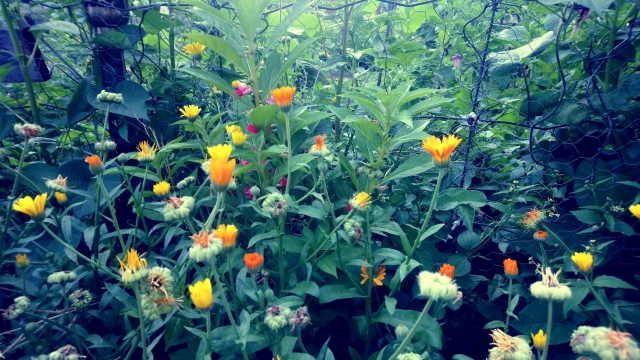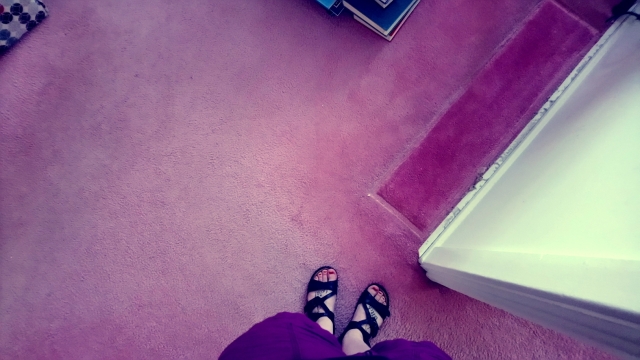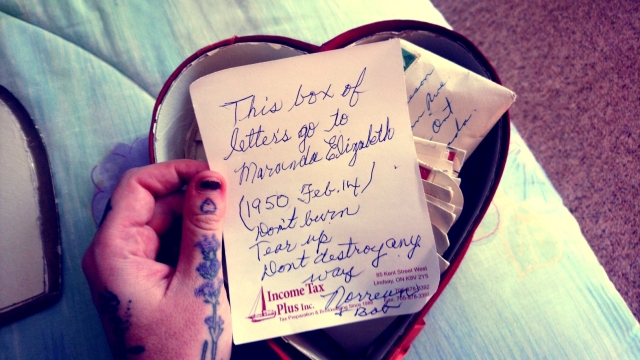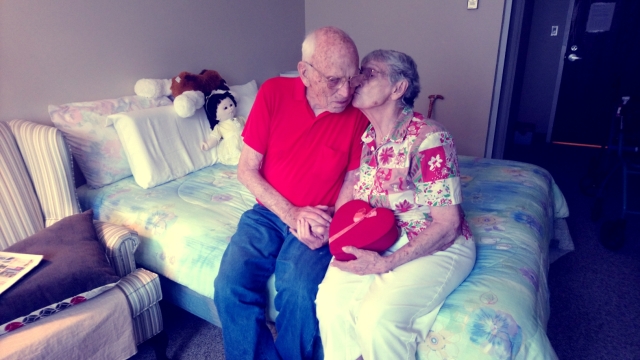{content notes: coma, death}
In Parkdale, sitting on the ground by the garden, I draw another Tarot card.
NINE OF CUPS
“Happiness.”
JUPITER IN PISCES.
Expansion, dreams, emotions, desires. Poetry, joy.
Those are among the first words to come to me.
But it sounds vague. This card dares me to be more specific.
{image description: My left hand hold’s onto the Next World Tarot’s Nine of Cups. Behind, the leaves of morning glories are visible, with green vegetables growing behind a fence in the background, and a tall apartment with beige balconies slightly in view beyond. The figure in the card revels in comfort and pleasure. Their hands are full of sweet and nourishing things, mouth wide open, ready to take them in, and their tattooed shoulder shows a stitched and mended heart. They wear a necklace of peaches and jewelry with spikes and rose quartz, protection and self-love. Their body is held above a flood through a neighbourhood similar to the low-income neighbourhoods where I reside, where I’ve been visiting my family’s past. Brown brick low-rises with curtained windows. Skin almost mauve, sky yellow, drinks pink. Bejewelled cups overflowing, tipsy and dancing. Toenails painted pink, barefoot outdoors in the city.}
This card reminds me of a CJ Sleez lyric, a line I learned as a teenager and continue to repeat to myself: “YOU’LL NEVER TAKE AWAY MY LUXURY IN POVERTY.”
For me, it means and also means beyond ‘poor people deserve nice things’ – which is very true, of course. And the nice things aren’t just things – they are also feelings of contentment, of emotional fulfillment, inhabiting moments of joy and pleasure, food that is fresh and nourishing, a sense of belonging (in place, body, environment, worlds), self-confidence, generosity, and meaning. Feelings of safety, stability, structure. To feel joy without the oft-accompanying guilt and shame.
The first time somebody said to me, “You’re allowed to want nice things,” it was a revelation. It still is.
{image description: Selfie in Parkdale. I’m wearing the same yellow & black dress with purple florals and a zippered collar described in Part One, and my heart-shaped shungite necklace. My hair is the same shades of green as the gardens surrounding. I’m wearing round glasses and I am unsmiling, chin held high.}
{image description: close-up of a pansy violet. The petals are open wide, deep purple on the inside and pale lilac on the outer parts. A tiny burst of yellow in the middle. The single flower is surrounded by green leaves of various sorts, low to the ground. To the bottom-right, there’s a thick exposed root that looks like it’s been pulled from the ground, tiny veins reaching outward}
I think about the way I have created my home, Amethyst Cathedral. My need for and focus on physical comfort, natural light with old filigree mirrors to reflect windows, tangible / visible reminders of who I am, what I do and why I do it, the air purifiers and essential oil diffusers that make my musty old apartment breathable, never-ending collection of books, alive plants & dead or dried plants & fake florals, small candles, branches I’ve gathered, colours and textures, my assorted collected of oft-mismatched bedding from thrift stores so I can make and re-make my bed to encourage certain moods (or not run out of pillowcases when I haven’t done laundry for a long time), drawers to tuck my messes away in, fuchsia and violet rugs to pretty up my home and reduce sound/noise between apartments, little altars everywhere…
Cristy Road says: “The 9 of Cups reminds us of the revolutionary role of self-care.”
When Audre Lorde wrote about self-care, she was being treated for, and eventually dying from, cancer. She was a Black lesbian writer articulating the meaning of her place, her life, her body, her illness, her desires, her role in her communities and in the world. Her work on self-care has often been co-opted, capitalized upon, detached from context, and diluted or, in a way, gentrified – I conjure the spirit of her work here in an imperfect effort to connect the necessity of self-care and the meaning that holds for me as someone who struggles to care for themself as an anti-capitalist sick crip writer on social assistance who will never ‘recover’ and cannot rely on others, professional or otherwise, for adequate and meaningful care; and the role of care and self-care in my home, a place that is a place where I am often sick, often debilitated, a place where I’ve experienced severe loneliness and fear, and also a place I am in love with, grateful for, where I’ve experienced love and connection, too. A place that is a home, and the place I have lived the longest since birth, as well as a place that is built on stolen land, and a place where the threat of eviction, of climate catastrophe, is ever-present. Self-care is meant to be anti-capitalist.
Amethyst Cathedral is both a place that has made me sick, and a place that has protected me. A place where I’ve been in danger, and a place where I seek safety, too. A place where I’ve wanted to die, and a place that’s kept me alive. Because I live here alone, it’s also the place where I can be the most “myself.”
{image description: One of many corners in my apartment, named Amethyst Cathedral. The wall is painted lavender, and to the right is a radiator painted silver, chipped. A floating shelf installed on the wall holds a series of jars containing pieces of natures, leaves, flowers, dead butterflies & moths, birch bark, birds’ eggs, feathers, etc., found on the ground over many years, as well as a teacup with lilacs painted on it, animal bones, amethysts, broken chuncks of concrete, and other such trinkets. A narrow blue vase contains dried remnants of some of the plants plucked in Part One. Below is a sturdy pine bookshelf holding many books, a bookshelf built by my poppa shortly after my grandparents were married.}
I learned recently that when my nana was living in the rooming house in Parkdale, she was living in a shack built onto the back of the house, a storage room repurposed to make a bedroom. This was the first time, at the age of eighteen, that she had her own room, the first time she had her own bed. This is where she was living when she got her job at the Eaton Centre, where she met the man who would become her husband, my poppa. When I initially learned about the house, and heard some of her stories, I mistakenly assumed it was a rooming house for young working women. It wasn’t until recently that I learned, or was reminded (I might’ve already known when I was much younger, and then forgotten) that her parents also rented a room in the house, and her sisters rented rooms there, too, which they shared with one another. There were other women renting rooms of their own, and a few older men, at least one of whom was retired. It would’ve been a tough place to start anew, especially after growing up on a farm in the Prairies, but would’ve been a very exciting adventure, too.
Returning to the Nine of Cups, I think about how my dreams are constrained under capitalism. I’m reminded of my fear that my creativity and dreams have a ceiling, that living in poverty = less access to basic needs, less access to learning environments (institutional and otherwise), and less autonomy to write what I need to write, and make and distribute it the ways I want to. I remember how trauma can be described as an injury to the imagination, and how chronic poverty is sustained trauma (then again, wealthy people are not particularly imaginative, huh? To make a generalization…).
I think of my imagination as injured, as in recovery.
Marilyn Manson sings: “I’m in recovery / I’m in recovery / I’m in recovery / from America.”
This card reminds me that other worlds are possible, and that we can find them, create them, as we survive the current state-of-things. That we’re building them and living them right now. This card reminds me that there are no ethical choices under capitalism, but I am allowed to experience pleasure and joy without explanation or apology. Also, that I don’t have to earn these feelings – I can just feel them.
{image description: The camera turns to the left, showing another corner of my apartment. The walls are lavender, art hangs upon them, and another solid and polished pine bookshelf is shown, once again containing many books, as well as a small but loud set of speakers my previous neighbour gave me to me when he moved out. To the left of the bookshelf is a stack of milkcrates, yellow & turquoise & black, containing a stereo I found on the ground, and a whole bunch of CD’s. The top shelf holds three candle holders made with reclaimed branches, prayer candles, books, and a ceramic vase/pitcher designed as a tree trunk with a small brown squirrel hunkered in under the handle. To the right, small elements of the kitchen are hidden in the shadows, with the stove visible on the other side of the wall, a heart-patterned tea towel hanging from the oven handle.}
From where I’m sitting, I see a row of brick houses across the street, many of which are under construction, shielded with scaffolding, yards dug up, renovations (and renovictions?) in-process.
{image description: A three-story duplex house painted down the middle, left side white, right side red. There are fir trees in front of the left side, hiding the porch. The red house on the right is exposed, lawn dug up to bare dirt, a green dumpster planted atop, half-full with debris. Yellow, red, and white scaffolding is built along the front of the house, building permits pasted in the window. Upstairs windows are torn out and boarded up.}
{image description: Camera turns to the right. The red side and the green dumpster are still visible, as well as some of the scaffolding. Next door is a similar house, detached, red brick, trim painted grim black, all windows shut up tight with white, a freshly paved path leading to a small concrete porch with three steps. The door is painted black. A once beautiful home now plain, austere, lacking character. To the right, another red brick building is boarded up, empty.}
{image description: Front-facing view of the empty house on the right of the previous photo. Five steps lead to a porch, with half a dozen skids piled alongside and nearby. On the porch, several unhinged doors lean against one another, blocking one half of the front window. The house has been split into apartments, two doors still in tact at the front, though one wonders if, under renovation, this’ll remain true, and/or how much the place will cost (if rented) afterward. The second-story is fully board up with fresh plywood, with a contractors’ company sign hanging in front.}
{image description: Milky Way Alley. This alleyway would’ve been across the street from my nana’s Parkdale home, a pathway behind the Parkdale Public Library. Red brick buildings on each side, yellow speed bump sign. Walls have been painted with graffiti over murals – the heads of a brown horse and a white horse are seen, with colourful tags everywhere else. At the end of the alleyway, trees are visible.}
{image description: Green green green leaves everywhere, with a wooden sign painted with black letters in Tibetan, information about the garden, with a local phone number.}
{image description: Golden-mango and blush-coloured flowers growing tall amongst a whole bunch of green, with a thin metal fence barely visible.}
Before I was able to finish writing my Toronto Forget-Me-Not series, my poppa died. I’d set the project aside for various reasons, some emotional, others practical. My hard drive crashed. I thought I’d lost everything. When much of it was retrieved, I didn’t want to look at it anymore. Other work distracted me. My birthday came and went. The landscape of Toronto continued changing, and I had frequent panic attacks. As Winter set in, I became more fatigued. Screens hurt my eyes, my brain. I read too many articles about surveillance, gentrification, criminalization of nearly all means of survival, and felt powerless beyond (sometimes) fiction, and I dissociated more often than I had been. I lost my concentration and I could barely read. I helped friends in crisis, and some friends left the city (again). I organized, and then I quit. I pinched a nerve in my right shoulder, limiting the use of dominant hand and arm.
Toward the end of his life, when my poppa was in a coma but still breathing, I was able to visit him at the hospital in my hometown. He was in the Palliative Care Unit, with my nana visiting him and sitting at his bedside everyday from 9am-4pm, when she went back to their retirement home, ate dinner, and went to bed. She told me she’d make sure to go to bed right away. When I arrived, I heard my nana singing to him. Though some had tried to insist he couldn’t hear from inside his coma, I knew this wasn’t true since I’d also been in a coma, but I couldn’t tell them because it wasn’t an appropriate time – in fact, I grappled for quite a while with whether or not I should share this information. When my nana told me on her own that she knew he could hear her, and hear us, I decided only to tell her she was probably right, and not say how I knew. She had a small, portable CD player at the bedside, which was turned off. My poppa looked more small and frail than usual, and his white beard, usually shaveds had begun to grow out. He was breathing on his own, but unmoving, and connected to morphine and nothing else. There was a large window near his bed where birdseed was gathered, and sparrows were fluttering about. My poppa was a birdwatcher, so we knew he’d appreciate this.
I sat at his bedside and described the view to him, the birds. I told him a bit about my current life, and some of my memories of him.
{image description: An expanse of of dusty rose carpet. My feet, in black sandals, are visible, toenails painted magenta, the edges of my purple shorts visible at the bottom edge of the frame. The corner of a white wall juts out on the right, and the edges of a stack of books are visible at the top right, and the tiniest piece of fabric of my poppa’s reading chair to the left. Most of the pink carpet is the same shade, except for a long rectangle to the right, where one of the shelves that’s since become mine has been moved, revealing a deeper, fresher pink underneath. The carpet was laid in the early-90’s, professionally cleaned a handful of times, and the furniture had remained in the same place all this time.}
I know it’s ordinary, but I’ve loved this carpet since childhood. It always felt soft and comforting beneath my feet. Sometimes my nana would lend us slippers to wear. I used to sit on the floor and play with Lincoln Logs and other toys, building tiny cabins and making stories with plastic Fisher Price figurines. I’d drink tea and try not to spill it. There were dinner trays painted a similar shade of pink.
{image description: My left hand holds onto a sheet of paper, which reads, in handwriting, blue ink:
This box of letter’s [sic] go to [sic] Maranda Elizabeth (1950 Feb 14).
Don’t burn
Tear up
Dont [sic] destroy [in] anyway
Norrean & Bob
The note is framed by a red heart-shaped box sitting on the bed where I’m sitting. Corners of aged white envelopes are sticking out.}
When I showed them the box of letters, I thought they’d feel embarrassed about it – and I definitely knew my poppa would tell me to destroy them, even if he were joking or pretending to. It was the first thing he said, of course. So I asked my nana to write this note and enclose it within the heart-shaped box. They told me they didn’t even remember the collection of mail, the valentine box.
{image description: My nana and poppa sitting beside one another on their bed at the retirement home, holding hands with one another. My poppa is on the left, both hands clasped around my nana’s right, while her left hand holds onto the heart-shaped box, now closed. A faded pinkish-red ribbon with a bow encloses the box, more decorative than functional. My nana and poppa, not knowing I’d be bringing them this valentine, had inadvertantly both dressed in red, matching. My poppa wears a red short-sleeved polo shirt and blue jeans. My nana wears a pink, red, and beige short-sleeved button-up shirt with a patchwork floral pattern and pale beige pants. She’s leaning over to kiss my poppa on the cheek as he leans toward her. In the background, one of my nana’s many handmade dolls rests against the pillows, as well as a stuffed brown and white dog. A turquoise rollator is seen to the right, and a wooden cane leaning against the wall behind them.}
I didn’t know this’d be the last time I took a photo of them together.
{image description: Another very purple corner of my apartment. One of the beautiful, polished pine furniture pieces my poppa built – an unfolding desk and dresser, currently folded closed. On top, prayer candles, a fuchsia essential oil diffuser, floral teacup and saucer, and a wooden document tray holding planters and ceramic animals with pens and pencil crayons, etc., stored within. Crystals and notes hang on my wall. My entrance door is to the left, locked, lavender, with a few empty totebags hanging from the doorknob.}
A piece of furniture I’ve always found romantic.
My twin and I often had morbid interests when we were growing up. I’ve written about this is in the past, but: as children, we would “call” items we get to keep when they die. One of the items I “called” as a child was this folding desk. My poppa used it to store files and documents, small containers with smaller toys, pictures. When the desk unfolds, smaller nooks and crannies are revealed. I forget what he kept in there except for his cigarettes and lighters, pens and paper, and small pieces of leather in various shades of brown – he made small leather crafts, which I always liked the smell of. It’s one of the skills I wish had been passed onto me. (But it’s not something I asked to be taught.) On top, ceramic trinkets, my nana’s camera, red and grey.
Now that the furniture is mine, it holds pens and papers, too. It holds a collection of snail mail supplies, old mugs re-purposed to hold writing and craft supplies, a few books, some trinkets passed onto me from my grandparents, and some of my poppa’s small leather-working tools. Other semi-organized things… The drawers hold vintage fabrics, knitting supplies, envelopes to re-use…
When it squeaks open and closed, when the handles gently clang against one another, the tiny sounds are so familiar and comforting. Almost out of place, though, or renewed somehow…
To be continued…
Pinefully Yours,
P.S.: Did you know that I recently launched a Patreon?! You can read more about my reasons for doing so, and my intentions, at Writing for weirdos, dreamers, survivors, and the dead, and you can take a look at the page itself at patreon/MarandaElizabeth.
P.P.S.: If you’ve benefited from my writing in any way – if my words have inspired you, helped you feel less alone, or sparked some weird feeling within you; if you’ve felt encouraged, or curious, or comforted – please consider compensating me by offering a donation of any amount. Whether you’ve been reading my writing for years, or just stumbled into me this afternoon, I invite you to help me sustain the process!





